



With the introduction of the new Legal Tender Note series on 10 September 1928, an Irish 10 Shilling note denomination appeared for the first time, apart from the irregular issue of Limerick Soviet notes in April 1919 during a general strike in the city.

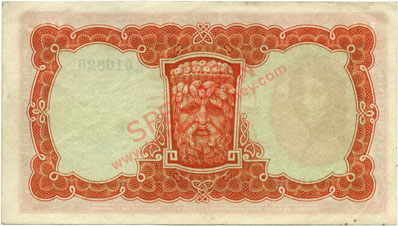
The Irish 10 Shilling note was in use for 40 years, from 1928 to 1968, with the last date being 6.6.68. This was the shortest lifespan of any of the denominations of the Series A Irish Legal Tender Notes. With decimalisation the Irish 10 Shilling note was replaced by a 50p coin, the earliest of which is dated 1969. As the lowest denomination Irish banknote, Irish Ten Shilling notes were widely issued throughout their lifespan from 1928 to 1968. The later dates of the notes are very common, with the final date 6.6.68 being readily available in uncirculated condition.
When the currency was decimalised in 1969, Ten Shillings was discontinued as a denomination, and a new 50 pence coin was introduced, leaving the £1 note as the lowest denomination banknote.
Irish Ten Shilling and One Pound notes accounted for the vast majority of the banknotes in circulation up to the end of the 1960s, with generally 500,000 notes per date being printed for both denominations, compared to generally 100,000 notes per date for £5 and £10 notes.
There were 100,000 notes printed per prefix for Irish 10 shilling notes up to 1950. From 1951 onwards serial numbers were extended to 1,000,000 notes per prefix.
Certain rarer dates of all denominations were produced which had much lower printages. How much is a Ten Shilling note worth today to banknote collectors depends largely on its age and condition. The highest price ever paid for a Lavery 10 Shilling note in auction was £2,400 plus fees for a 23.10.28 in AU grade, noonans.co.uk, 12 October 2023.
The board lists the current numismatic value of Irish 10 Shilling notes.
The choice to introduce a 10 Shilling note, would likely have been affected by several issues.
The most likely of these may have been the fact that the UK had introduced a 10 Shilling denomination as part of the treasury note issue in August 1914 [1.]. The Bank of England then introduced a 10 Shilling denomination in its place in 1928 [2.], the Series A Britannia Issue, around the same time as the creation of the Irish Legal Tender Note issue.
Another consideration was that a lesser amount of Irish coinage would be needed in circulation if an Irish 10 Shilling note was introduced.
The reasoning behind the introduction of an Irish currency note denomination of Ten Shillings in 1928 remains to be fully investigated in the Central Bank of Ireland Archives.
The smaller version of the portrait of Lady Lavery was used on the 10 Shilling note. On the 10 Shillings, the portrait is 40mm high.
Dimensions of the Irish 10 Shilling Note are approximately 138 x 78 mm. This was measured on a note dated 10.9.28. The dimensions of the banknotes can vary by a couple of millimetres.
The colour orange was chosen for the new 10 Shilling notes. It is known that other colours were considered for the Irish Ten Shilling note, specifically green, as partial proofs survive of a green printing of the 10 Shilling note.

Proof vignette on paper for the left side of 10 Shillings. [5. noonans.co.uk, 12 March 2020, Lot 149]

Partial proof of 10 Shillings, 1928, printed in green ink [7. noonans.co.uk, 24 Feb 2022, Lot 420]

Obverse die proof in black ink of a 10 Shilling note design for the 1938 Currency Commission Ireland design. [6. noonans.co.uk, 26 Aug 2021, Lot 271]
A 'River mask' taken from the facade of the Custom House in Dublin was selected for the centrepeice of the reverse of the banknote.
For the 10 Shillings, the mask representing the River Blackwater in Co. Armagh was used. The river spirit is depicted wearing a headdress of a basket of apples on a carpet of fish [3. Moynihan 1975, p. 127].

Left, the engraving of the Blackwater river mask, taken from the original (right) which adorns the facade above one of the windows on the front of the Custom House in Dublin. [4. Image at right ©Karl Whitney]
Ten Shilling notes were issued under all of the design and signature variations for the Series A Legal Tender Notes up to 1968.

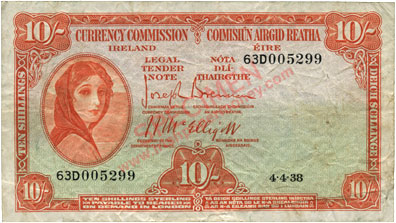
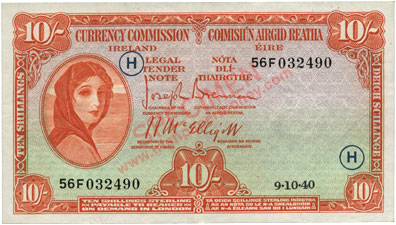
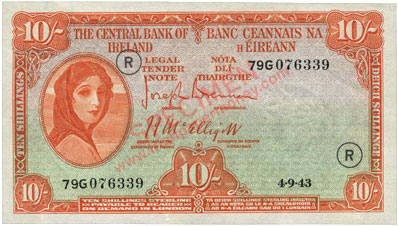





A major variation in design was the incorporation of a Special Identification Marking (SIM) 'War Code' into the design of the Ten Shilling note during the World War 2 Emergency period. The War code is also sometimes referred to as an Emergency Tracer Overprint (ETO) code, although the code is not actually an overprint. 10 Shilling notes bearing the SIM war code were issued under both Issuing Authorities, Type 4 (1940-1941), and Type 5 (1943-1944).
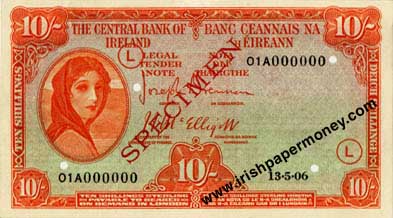
Seven war code combinations were used on the 10 Shilling note denomination.
Letters H, K, and J were used for Currency Commission issues on 10 Shilling notes with dates in 1940 and 1941.
On the Central Bank of Ireland 10 Shillings, letters L, M, R, and E were used with dates in 1943 and 1944.
Ten Shilling notes exist with the displaced code variety, where for certain dates, the last date of a war code exists with the previous code. These are very rare.
The bilingual text, in Englsh on the left and in Irish on the right at the bottom of each note indicates the link at parity with Sterling.
'Ten Shillings Sterling payable to bearer on demand in London'
'Tá Deich Scillinge Sterling iníoctha as an nóta so le n-a shealbhóir ar n-a éileamh san do i Lundain'

1928–1959 Sterling Promise in the bottom panel of every Lady Lavery Ten Shilling note
The sterling promise text was removed from the design on all notes printed from 1961 onwards.

1962–1968 Sterling promise replaced by denomination 'TEN SHILLINGS' 'DEICH SCILLINGE' in words
All Legal Tender Notes were printed on watermarked paper. The watermark consisted of the Head of Eirin on the bottom right of each note on all denominations, with additional watermarks in the centre of each denomination.
The centre watermarks varied on some denominations, and can be difficult to see. On Irish Ten Shilling notes the denomination of the note in the centre, 10/-, is seen with the letters LTN above it, as illustrated below.

The watermarks can be seen on this illustration of a 1957 Lavery Ten Shilling note, the letters 'LTN' above '10/-' and the Head of Eirin on the right

A Portals Archive watermarked paper example of the 10 Shillings Irish Legal Tender Note [8. noonans.co.uk, 2023, ex-Lot 332]
Each of the Series A banknotes incorporated several tiny security features in their designs on the face of every note. These features were in the form of little symbols and asymmetries in the design.
The 10 Shilling notes contained four such security marks, which are illustrated below.
In addition to the security marks there was printed a tiny Plate Tracer code, or plate letters, on the face and reverse of all Ten Shilling notes printed by Waterlow and Sons Ltd. These letters marked the position of each note on the sheet of printed notes.
These PT codes disappeared from the notes when De La Rue took over the printing, with the last such code letters appearing on the reverse of some 10 Shilling notes dated in 1959. The location of the PT codes is also illustrated.

There are 231 dates for the Irish Ten Shilling note, from 10.9.28 to 6.6.68. The range of dates includes 31.12.29, the only Lavery note with a date in 1929.
There are several rare dates by printage for the Irish 10 Shilling notes: 31.12.29, 1.12.41, 12.12.45, 13.08.46, 14.7.47, 10.2.49, 24.10.50. Several other dates are scarce and seldom offered.

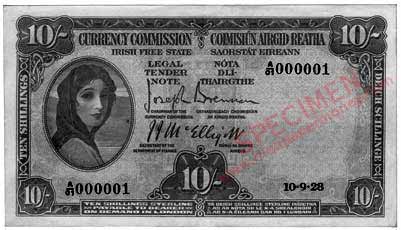
The first commemorative Irish coin, and the only commemorative pre-decimal coin, was issued on April 12, 1966 to mark the 50th anniversary of the 1916 Easter Rising.
Its issue occurred a few years before the last Irish 10 Shilling note date, 6.6.68, and the subsequent withdrawal of the 10 Shilling note denomination.
There might have been an intention of introducing a 10 Shilling coin in place of the 10 Shilling note. However, the 'Pádraig Pearse' Ten Shilling coin proved to not be a success. The coin was disliked in circulation, due in part to its weight [9. Young, 1979].
Illustrated below is a circulated example of the Pearse Ten Shilling coin which was kept from circulation in 1966.

Of the 2 million Ten Shilling coins issued, around 1.27 million were subsequently withdrawn and melted by the Central Bank of Ireland when the Irish currency was decimalised in 1971. A decimal 50 pence coin, a face value equal to 10 Shillings, was introduced with earliest date 1969.
Later, in the 1980s, the Pearse 10 Shilling coin also suffered from the fact that the value of its silver content exceeded its face value which resulted in more coins being melted privately for their silver content.
The 'Pádraig Pearse' Irish Silver 1966 Ten Shilling coin is 83.333% silver and 16.666% copper. It is a common coin.
For more on the Pearse 10 Shilling coin go to www.irishcoinage.com.
References
1. https://www.lbma.org.uk/alchemist/issue-73/the-great-financial-crisis-of-1914 [Last accessed 31.10.23].
2. https://www.natwestgroupremembers.com/banking-in-wartime/banking-business/gold-banknotes-and-money-supply-in-the-first-world-war.html [Last accessed 31.10.23].
3. Moynihan, Dr. M. 'Currency and Central Banking in Ireland 1922–1960', Gill & Macmillan and The Central Bank of Ireland, 1975.
4. Image ©Karl Whitney. Riverine keystone head at the Custom House, Dublin, rendered in Portland stone by Edward Smyth, portraying one of the rivers of Ireland - in this case, the Blackwater. (Identified by Harold Leask). https://source.southdublinlibraries.ie/handle/10599/5553/simple-search?filterquery=Custom+House&filtername=subject&filtertype=equals [Last accessed 31.10.23]
5. Auction Catalogue, Noonan's (DNW), London. Irish Banknotes, 12 March 2020.
6. Auction Catalogue, Noonan's (DNW), London. British, Irish and World Banknotes, 26 Aug 2021.
7. Auction Catalogue, Noonan's (DNW), London. British, Irish and World Banknotes, 24 Feb 2022.
8. Auction Catalogue, Noonan's (DNW), London. British and Irish Banknotes, 12 Oct 2023.
9. Young, D. (Nov-Dec 1979). The Pearse Commemorative, Irish Numismatics Magazine, No. 72, pp. 266-267.
Special Sections and Articles
The Transition of Irish Currency, Irish banknotes 1918–1928
The Partition of Irish Currency, Irish banknotes 1928–1930
Banknote Design Evolution 1824 to 1916
Irish Three Pound Notes
Contemporary Forgeries of Early Irish Banknotes, ca1800-1930
Limerick Soviet Notes
Irish World War 2 Banknote Issues
Low Number Irish Banknotes
Irish Joint Stock Banks of Note Issue from 1783
Irish Legal Tender Note Specimens
Ploughman Scan Survey (PSS)
1 Pound Ploughman
5 Pounds Ploughman
10 Pounds Ploughman
20 Pounds Ploughman
50 Pounds Ploughman
100 Pounds Ploughman
Irish Ten Shilling Notes
1 Pound Note Lady Lavery
5 Pounds Lady Lavery
10 Pounds Lady Lavery
20 Pounds Lady Lavery
50 Pounds Lady Lavery
100 Pounds Lady Lavery
1 Pound Note, Queen Medb
5 Pound Note, John Scotus Eriugena
10 Pound Note, Jonathan Swift
20 Pound Note, W. B. Yeats
50 Pound Note, Turlough O'Carolan
100 Pound Note, Grace O'Malley
5 Pound Note, Sister Catherine McAuley
10 Pound Note, James Joyce
20 Pound Note, Daniel O'Connell
50 Pound Note, Douglas Hyde
100 Pound Note, Charles Stewart Parnell
![]() Page under active revision, last update 23.12.24
Page under active revision, last update 23.12.24
